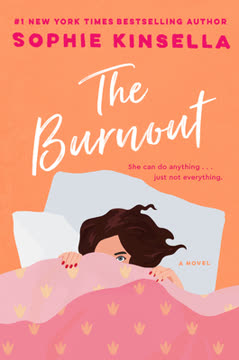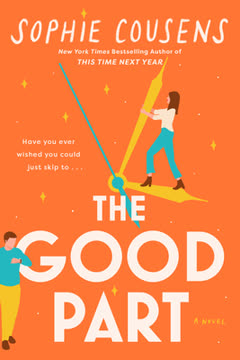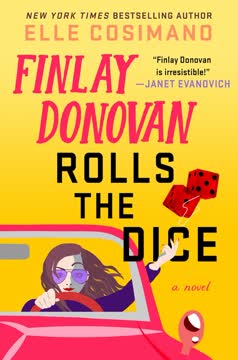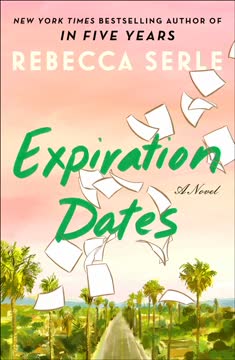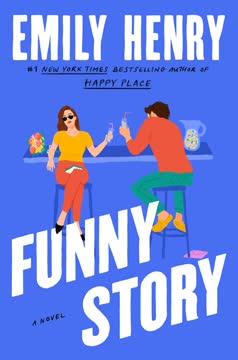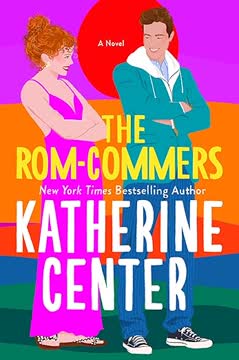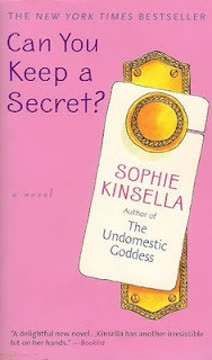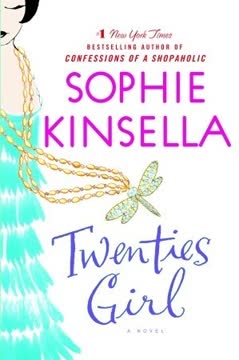Plot Summary
Emails, Exhaustion, and Escape
Sasha, a high-achieving marketing director at a buzzy travel app, Zoose, is drowning in emails, overwork, and the relentless pressure of a toxic, under-resourced workplace. Her boss, Asher, is inept and self-important, while the company's "well-being" initiatives only add to her stress. Sasha's life outside work is equally depleted—her flat is a mess, her social life is a string of WhatsApp lies, and she's lost all interest in sex and joy. After a humiliating encounter at Pret A Manger, Sasha's burnout peaks. She realizes she can't go on and, after a public meltdown at work, is signed off for three weeks by her doctor. Her family, well-meaning but overwhelming, urge her to take a real break. Her mother suggests a return to Rilston Bay, the seaside town of Sasha's happiest childhood memories.
The Nun Next Door
Overwhelmed by her job and unable to get help from management, Sasha impulsively flees the office and, in a moment of desperation, tries to join the convent across the street. The nuns, however, are not as welcoming as she hoped, and her attempt at escape is foiled by her well-being officer, Joanne, who chases her down. Sasha's breakdown is public and humiliating, culminating in her running into a brick wall and ending up in A&E. Her family rallies around, and her mother insists she needs a complete rest, not just a change of scene.
Running Into Burnout
Sasha's collapse is both physical and emotional. Signed off work, she's forced to confront the reality of her burnout. Her mother and sister try to help, but their solutions—menopause coaching, moving in with relatives—only highlight Sasha's sense of failure. The only idea that sparks hope is her mother's suggestion to return to Rilston Bay, a place of childhood joy. Despite her doubts about a winter visit, Sasha is drawn to the idea of healing by the sea, and her mother enthusiastically arranges everything, including a "wellness program" from an app.
Rilston Bay Retreat
Sasha arrives at the faded Rilston Hotel, expecting healing and tranquility. Instead, she finds a rundown hotel, boarded-up sea views, and a "beach lodge" offered as compensation. The town is empty and dreary in winter, and the wellness program—wild swimming, grounding, manifesting—proves more daunting than inspiring. Sasha's attempts at self-care are comically unsuccessful, and she finds herself sneaking junk food and hiding from the staff, who believe she's a health guru. The only other guest using the lodges is Finn Birchall, a tense, brooding man with his own baggage.
The Beach Lodge Letdown
Sasha's attempts at wellness are undermined by the reality of cold, loneliness, and her own exhaustion. Her efforts at wild swimming and yoga are failures, and she's haunted by the sense that she can't even "do" relaxation right. The arrival of Finn, who is equally burned out and prickly, disrupts her fragile sense of control. Their initial encounters are antagonistic, each misjudging the other as sanctimonious or rude. Yet, beneath the surface, both are struggling with similar demons of overwork, disappointment, and loss of self.
The Wellness Program Fails
Sasha's attempts to follow the 20 Steps to a Better You app become increasingly absurd. She can't meditate, can't hula-hoop, and can't stop eating crisps. The hotel staff, especially Cassidy, treat her as a celebrity health influencer, while the hotel's app bombards her with irrelevant notifications. Sasha's sense of failure deepens, but she finds unexpected comfort in small acts of rebellion—junk food, old movies, and honest conversations with her friend Dinah. Meanwhile, Finn's presence on the beach becomes a constant, irritating reminder of her inability to "get better."
Manifesting and Misdirection
Sasha tries to "manifest" a new life, writing down her wishes for sexual desire and world peace, only to lose the note—where Finn finds it and reads her most private thoughts. Mortified, Sasha is forced to confront her numbness and longing. The two begin to interact more, their antagonism giving way to reluctant camaraderie. Both are haunted by the past: Sasha by her father's death and the last family holiday at Rilston, Finn by a mysterious work meltdown. A series of cryptic messages and gifts appear on the beach, addressed to "the couple on the beach," deepening the sense of mystery.
Clash of Burnouts
A series of misunderstandings and confrontations bring Sasha and Finn's issues to the surface. Each accuses the other of being a fraud—Sasha for her fake healthiness, Finn for his supposed anger issues. When Finn is injured by a waiter's accident, the truth comes out: he wasn't being cruel, just in pain. Their mutual apologies mark a turning point. They begin to share more honestly, bonding over their shared childhood memories of Rilston, their admiration for their old surf teacher Terry, and their struggles with burnout. The messages on the beach become a shared puzzle.
Secrets, Snacks, and Surf
Sasha and Finn's friendship deepens as they confide in each other about their burnout, failed relationships, and lost sense of self. They reminisce about Terry, the legendary surf teacher, and the mysterious kayak accident that ended their childhood holidays. Both are haunted by the sense that they were present at a pivotal moment but can't remember the details. Their attempts at wellness become more about supporting each other than following the app. The hotel's eccentric staff and the town's oddities provide comic relief and a sense of community.
Champagne and Confessions
After finding a bottle of champagne and more mysterious messages, Sasha and Finn share a sunset drink on the beach. They open up about their work meltdowns, their sense of failure, and their longing for happiness. The conversation turns to sex, and Sasha confesses her numbness and desire to "wake up." Finn admits to his own struggles with anger and insomnia. Their honesty leads to a new intimacy, and they begin to see each other as more than just fellow sufferers. The possibility of romance flickers, but both are wary.
The Mystery of the Messages
The cryptic beach messages, always addressed to "the couple on the beach," become a central mystery. Sasha and Finn investigate, suspecting everything from art projects to secret admirers. Their search leads them to revisit the past: the kayak accident, the police investigation, and their own roles as children. Encounters with Terry, now frail but still wise, and his daughter Tessa, add layers to the puzzle. The messages force both to confront their own histories and the ways they've been shaped by loss, guilt, and longing.
Surfing the Past
A chance encounter with Terry's daughter reveals the truth: the messages are from Tessa, thanking Sasha and Finn for saving Terry's reputation after the kayak accident. As children, they both witnessed Pete, the rival surf shop owner, burning evidence to frame Terry. Their testimony to the police cleared Terry's name and allowed him to continue teaching for twenty more years. The revelation brings closure and a sense of purpose. At a community art event, they are celebrated for their role in the town's history, and the meaning of "the ride is it" becomes clear: life is about embracing the journey, not the outcome.
Terry's Last Lesson
Sasha organizes a massive reunion for all of Terry's former pupils, bringing hundreds to Rilston Bay for one last surf lesson. Terry, though frail, is honored and uplifted by the outpouring of love. The event is a cathartic celebration of resilience, community, and the power of small acts to change lives. Sasha's family, Finn, and the quirky hotel staff all play a part. The day is filled with laughter, tears, and the sense that healing is possible—not through perfection, but through connection and acceptance.
Healing, Hope, and Heartbreak
As Sasha's time at Rilston ends, she faces the reality of her feelings for Finn. Both have grown and healed, but Finn's emotional unavailability—rooted in a past heartbreak—prevents them from fully committing. They part as friends, each carrying a piece of hope and a piece of pain. Sasha returns to London, stronger and more self-assured, ready to rebuild her life on her own terms. She takes a new job, sets boundaries, and reconnects with her passions. The lessons of Rilston—enjoy the ride, seize the wave—become her new mantra.
The Return to Life
Back in London, Sasha applies the lessons of her retreat. She takes ownership at work, sets healthy boundaries, and becomes a supportive leader. Her flat is no longer a symbol of failure but of growth. She maintains her friendships, cooks real meals, and even influences her old company's wellness program. The burnout is not erased, but it is integrated—a scar that reminds her to value herself. She and Finn stay in touch, their friendship deepening into something more mature and honest.
The Not-Couple's Goodbye
At a grand reunion in Rilston, Sasha and Finn work together to honor Terry and the community that shaped them. The event is a triumph, but the question of their relationship lingers. Misunderstandings and unspoken fears keep them apart, each believing the other is unavailable. Yet, as the day ends and the beach empties, they find themselves alone once more, the possibility of love rekindled by honesty and hope.
The Ride Is It
In a final, private moment on the beach, Sasha and Finn confront their fears and miscommunications. Both have been carrying hope for each other, manifesting love in secret. With the help of friends and a little magic from the Rilston community, they finally admit their feelings and choose to walk forward together. The message of Terry's teaching—enjoy the ride—becomes their shared philosophy, as they step into a future built on resilience, honesty, and joy.
Reunion on the Sand
Months later, Sasha and Finn are thriving—individually and as a couple. Sasha leads her department with confidence, Finn has found balance and healing, and both remain connected to the Rilston community. The story ends with a celebration of love, friendship, and the enduring power of small acts to change lives. The ride is it, and they are finally ready to enjoy it—together.
Characters
Sasha Worth
Sasha is a thirty-something marketing director whose life is derailed by overwork, toxic management, and a loss of self. Her journey is one of collapse and renewal: from panic attacks and numbness to rediscovering joy, desire, and agency. Sasha's relationships—with her family, friends, and especially Finn—are marked by vulnerability, humor, and a deep longing for connection. Her psychological arc is about learning to set boundaries, value herself, and embrace imperfection. Sasha's development is realistic and hard-won; she doesn't find a magic cure, but she does find the strength to rebuild her life on her own terms.
Finn Birchall
Finn is a management consultant who arrives at Rilston Bay as a fellow burnout, hiding his own pain behind sarcasm and withdrawal. Initially prickly and defensive, Finn gradually reveals a deep well of kindness, wisdom, and vulnerability. His past heartbreak and sense of responsibility have left him emotionally closed, but through his friendship with Sasha, he learns to trust, confide, and hope again. Finn's journey mirrors Sasha's: from isolation to connection, from denial to honesty. His love for Sasha is transformative, but only possible once he faces his own wounds.
Terry Connolly
Terry is the iconic surf teacher of Rilston Bay, a figure of wisdom, humor, and community spirit. Though now frail and suffering from memory loss, Terry's teachings—"the ride is it"—anchor the novel's themes. He represents the power of small acts, the importance of resilience, and the enduring impact of kindness. Terry's relationship with Sasha and Finn is both personal and symbolic; he is the catalyst for their healing and the heart of the Rilston community.
Cassidy
Cassidy is the young, irrepressible receptionist at the Rilston Hotel, whose enthusiasm and lack of boundaries provide much of the novel's humor. She becomes Sasha's unlikely ally, championing her as a wellness guru and orchestrating key moments of connection. Cassidy's warmth and resourcefulness embody the spirit of the Rilston community.
Joanne
Joanne is the embodiment of corporate wellness gone wrong: rigid, performative, and blind to real human needs. Her interactions with Sasha highlight the absurdity of superficial solutions to deep problems. Joanne's inability to listen or adapt makes her both a source of comic frustration and a warning about the dangers of toxic positivity.
Lev Harman
Lev is the founder of Zoose, charismatic but increasingly absent from the company he built. His struggle to manage growth, family, and values mirrors Sasha's own journey. Lev's eventual willingness to listen, change, and empower Sasha is a turning point for both the company and the protagonist.
Tessa Connolly
Terry's daughter, Tessa, is a quiet but pivotal figure. Her secret messages on the beach are acts of gratitude and remembrance, connecting past and present. Tessa's journey from silence to speaking up is a subtle but powerful parallel to Sasha's own growth.
Hayley and Adrian West
The Wests are a couple on the brink of divorce, whose struggles with communication and resentment echo Sasha and Finn's own challenges. Their eventual reconciliation, prompted by honest conversation, serves as a hopeful counterpoint and a lesson in the importance of vulnerability.
Simon Palmer
The manager of the Rilston Hotel, Simon is perpetually overwhelmed but deeply committed to his guests. His comic apologies and earnestness provide both levity and a sense of genuine care. Simon represents the imperfect but loving support systems that make healing possible.
Dinah
Dinah, Sasha's old friend, is a doula whose labor metaphors and unwavering belief in Sasha's strength provide crucial encouragement. She is a reminder that healing is a communal effort, and that friendship can be as transformative as romance.
Plot Devices
Burnout as Catalyst
The novel uses burnout not just as a plot point but as a lens through which to examine modern life, work, and relationships. Sasha's collapse is both a personal crisis and a societal commentary, driving her to seek change, connection, and meaning. The narrative structure mirrors her journey: from chaos to clarity, from isolation to community.
Parallel Journeys
Sasha and Finn's stories run in parallel, each reflecting and challenging the other. Their initial antagonism gives way to mutual support, and their shared history at Rilston becomes a metaphor for the possibility of renewal. The use of dual perspectives and mirrored experiences (work meltdowns, childhood memories, failed relationships) creates a sense of intimacy and inevitability.
Mystery and Messages
The cryptic messages on the beach serve as both a literal mystery and a metaphor for the hidden connections between people. Their gradual unraveling brings past and present together, forcing the characters to confront their histories and the impact of small acts. The messages also provide foreshadowing and a sense of magical realism, suggesting that healing is both ordinary and extraordinary.
Comic Relief and Community
The novel uses humor—through the hotel staff, wellness app absurdities, and Sasha's inner monologue—to offset the heaviness of burnout and loss. The Rilston community, with its quirks and kindness, becomes a character in itself, embodying the idea that healing happens in relationship, not isolation.
Foreshadowing and Callbacks
Phrases like "the ride is it," "infinite waves, infinite chances," and the motif of the sea recur throughout the novel, reinforcing the central themes. Childhood memories, lost notes, and repeated misunderstandings are used to foreshadow later revelations and to show the cyclical nature of healing and growth.
Analysis
The Burnout is both a sharp satire of contemporary work culture and a heartfelt exploration of what it means to rebuild a life after collapse. Sophie Kinsella uses humor, romance, and mystery to make profound points about the dangers of overwork, the emptiness of performative wellness, and the necessity of real connection. The novel's central lesson is that healing is not about perfection or following a program, but about honesty, vulnerability, and community. Through Sasha and Finn's intertwined journeys, Kinsella shows that burnout is not a personal failure but a call to reimagine what matters. The story's ultimate message—"the ride is it"—is a call to embrace imperfection, seize joy where we find it, and trust that even after the worst wipeouts, there are always more waves to catch.
Last updated:
FAQ
Synopsis & Basic Details
What is The Burnout about?
- A Modern Escape Narrative: The Burnout follows Sasha Worth, a high-achieving marketing director at a fast-paced travel app, Zoose, who finds herself completely overwhelmed by work stress, toxic corporate culture, and a profound sense of emotional numbness. Her life spirals into a state of chronic exhaustion and anxiety, leading to a public breakdown.
- Journey to Self-Discovery: Forced to take a break, Sasha retreats to Rilston Bay, a nostalgic seaside town from her childhood, hoping to find peace and rediscover herself through a rigid "wellness program." Instead, she encounters a dilapidated hotel, eccentric staff, and Finn Birchall, a similarly burned-out management consultant, whose prickly demeanor initially clashes with her own.
- Healing Through Connection: The story charts Sasha's and Finn's parallel journeys from isolation and denial to vulnerability and genuine connection. Through shared experiences, uncovering a local mystery, and the unexpected wisdom of a beloved surf teacher, they learn to confront their pasts, embrace imperfection, and find healing not in prescribed steps, but in authentic relationships and a renewed appreciation for life's "ride."
Why should I read The Burnout?
- Relatable Commentary on Modern Life: The Burnout offers a sharp, humorous, and deeply empathetic look at the pressures of contemporary work culture, the absurdity of performative wellness, and the universal struggle to find balance and meaning. Readers grappling with stress, anxiety, or a feeling of being "stuck" will find Sasha's journey profoundly resonant.
- Heartwarming Romance and Community: Beyond its social commentary, the novel delivers a compelling slow-burn romance between two flawed but endearing protagonists. Their journey is enriched by a quirky cast of supporting characters and the vibrant, supportive community of Rilston Bay, offering a comforting escape and a reminder of the power of human connection.
- Inspiring Message of Resilience: Sophie Kinsella masterfully blends humor with poignant emotional depth, crafting a story that is both entertaining and genuinely uplifting. It's a testament to resilience, the importance of self-worth, and the idea that even after hitting rock bottom, it's possible to rebuild a life filled with joy, purpose, and love.
What is the background of The Burnout?
- Contemporary Corporate Culture Critique: The novel is set against the backdrop of a modern, high-pressure corporate environment, specifically a "buzzy start-up" travel app called Zoose. It critiques the relentless demands of email culture, the superficiality of corporate "well-being" initiatives (like the "joyfulness program" and "aspirations mood board"), and the impact of understaffing and poor management on employee mental health.
- Nostalgic Seaside Setting: The primary setting, Rilston Bay, is a fictional English seaside town that serves as a nostalgic anchor for Sasha's childhood memories. Its depiction as a faded, off-season resort contrasts sharply with the bustling summer memories, symbolizing Sasha's own depleted state and the need for renewal. The town's reliance on tourism and its close-knit community provide a counterpoint to Sasha's isolated London life.
- Exploration of Wellness Trends: The story subtly satirizes contemporary wellness trends through Sasha's "20 Steps to a Better You" app, which promotes activities like wild swimming, grounding, and manifesting. This cultural context highlights the often-unrealistic expectations placed on individuals to "fix" themselves through superficial means, rather than addressing deeper systemic or emotional issues.
What are the most memorable quotes in The Burnout?
- "The ride is it.": This recurring mantra from Terry, the beloved surf teacher, encapsulates the novel's central theme of embracing life's journey rather than fixating on the destination or outcome. It appears multiple times, from Terry's initial lessons to his final, poignant advice, and becomes a guiding philosophy for Sasha and Finn.
- "Why are you worrying about the sea? The sea sure as hell isn't worrying about you!": Another of Terry's profound observations, this quote serves as a powerful metaphor for letting go of anxieties and external pressures. It highlights the futility of overthinking and encourages a more present, accepting approach to life's challenges, echoing Sasha's struggle with her overwhelming thoughts.
- "I thought I was at the beginning of something beautiful, but instead I was in the middle of another couple's blip. I just didn't know it.": This poignant internal monologue from Sasha, after discovering Finn's past relationship, perfectly captures her vulnerability and the painful realization that her hopes were built on a misunderstanding. It underscores the theme of self-deception and the importance of clear communication in relationships.
What writing style, narrative choices, and literary techniques does Sophie Kinsella use?
- First-Person Narrative with Inner Monologue: The story is told from Sasha's first-person perspective, allowing deep access to her frantic, often humorous, and self-deprecating inner thoughts. This narrative choice effectively conveys her burnout and anxiety, making her struggles highly relatable and her eventual growth more impactful.
- Satirical and Humorous Tone: Kinsella employs a signature blend of lighthearted humor and sharp satire, particularly in her depiction of corporate culture, wellness trends, and the eccentric Rilston Hotel staff. This comedic approach provides much-needed levity, balancing the more serious themes of mental health and personal crisis.
- Symbolism and Recurring Motifs: The novel is rich with symbolism, such as the sea representing life's unpredictable nature, the dilapidated Rilston Hotel mirroring Sasha's state, and the "20 Steps" app symbolizing superficial solutions. Recurring motifs like the "couple on the beach" messages, Terry's sayings, and the act of surfing reinforce the themes of connection, resilience, and embracing the present moment.
Hidden Details & Subtle Connections
What are some minor details that add significant meaning in The Burnout?
- The Supermarket Guy's Discretion: The silent supermarket guy who sells Sasha junk food and Club biscuits, then says, "I don't see nothing. I don't say nothing. More to life than kale," subtly highlights the community's quiet understanding and acceptance of imperfection. This contrasts sharply with the judgmental "wellness" culture Sasha fled, showing a genuine, non-performative form of care.
- The Rilston Hotel's "Antiques Shop": The lobby filled with old furniture for sale, including a mangle and a grand piano marked "Free to good home," symbolizes the hotel's desperate financial state and faded glory. This detail mirrors Sasha's own feeling of being "used up" and undervalued, but also hints at the potential for renewal and finding value in what's old or overlooked.
- Sasha's Pret A Manger Order: Her nightly purchase of the "falafel and halloumi wrap, a choc bar, some kind of 'healthy' drink in a can, and a bircher muesli" reveals the rigid, almost ritualistic nature of her burnout. It signifies her inability to make even simple decisions or engage with the joy of food, a stark contrast to her later rediscovery of cooking and varied meals.
What are some subtle foreshadowing and callbacks in The Burnout?
- Terry's "Infinite Waves, Infinite Chances": This phrase, recalled by Sasha and Finn from their childhood surf lessons, subtly foreshadows their individual and collective journeys of resilience. It suggests that despite setbacks (wipeouts), there are always new opportunities for growth and success, reinforcing the idea that life is a continuous process of learning and trying again.
- The "Couple on the Beach" Messages: Initially dismissed by Sasha and Finn as art or fan tributes, these messages ("To the couple on the beach. Thank you. 8/18") subtly foreshadow the revelation of their shared past and the profound impact of their childhood actions. The repeated date, August 18th, acts as a persistent clue, drawing them deeper into the mystery of their own history.
- Sasha's "Genitals Rubbing Together" Comment: This seemingly crude and self-deprecating remark to the Pret guy, while initially a sign of her emotional numbness, subtly foreshadows her eventual sexual reawakening. It sets a low bar for her libido, making her later desire for Finn a more powerful and surprising transformation, highlighting the depth of her healing.
What are some unexpected character connections in The Burnout?
- Sasha and Finn's Shared Childhood History: Beyond their parallel journeys of burnout experiences, the most unexpected connection is their shared past at Rilston Bay, including surf lessons with Terry and witnessing the same kayak accident. This deepens their bond, suggesting a fated connection that predates their adult struggles and provides a foundation for their mutual understanding and healing.
- Lev Harman's Vulnerability and Connection to Terry: Lev, the charismatic founder of Zoose, initially appears as an almost mythical, unreachable figure. His unexpected visit to Rilston and his genuine engagement with Sasha's feedback, coupled with his humble interaction with Terry ("The single most important thing I should know"), reveals a surprising vulnerability and a shared appreciation for authentic wisdom, bridging the corporate world with the simple truths of the beach.
- The Rilston Staff as a Found Family: While individually quirky, the collective staff—Cassidy, Simon, Nikolai, Herbert—form an unexpected, albeit dysfunctional, supportive community. Their earnest attempts to care for guests, despite their limitations, create a sense of belonging for Sasha and Finn, contrasting with the impersonal nature of their corporate lives and highlighting the importance of human warmth over efficiency.
Psychological, Emotional, & Relational Analysis
What are some unspoken motivations of the characters in The Burnout?
- Finn's Protective Silence: Finn's initial reluctance to fully disclose the real reason for his burnout (covering for a sick colleague, not just overwork or a breakup) is driven by a deep-seated sense of loyalty and a fear of appearing vulnerable or "a liability." This unspoken motivation reveals his profound empathy and self-sacrificing nature, even as it causes misunderstandings with Sasha.
- Sasha's Fear of Failure and Self-Worth: Sasha's inability to leave her toxic job or even make simple life choices stems from an unspoken fear of failure and a diminished sense of self-worth. Her constant apologies and people-pleasing ("Sorry," "I must type those words, what, twenty times a day?") mask a deeper anxiety about not being "enough," which her burnout has exacerbated.
- Joanne's Need for Control and Validation: Joanne, the well-being officer, is motivated by an unspoken need for control and validation within the corporate structure. Her rigid adherence to "joyfulness programs" and her judgmental attitude towards Sasha's "lack of engagement" are less about genuine care and more about asserting her authority and proving her own value in a system she believes in.
What psychological complexities do the characters exhibit in The Burnout?
- Sasha's Dissociation and Emotional Numbness: Sasha exhibits a profound psychological complexity through her emotional numbness and dissociation, particularly regarding her libido and ability to experience joy. Her "genitals rubbing together" comment is a stark manifestation of this, indicating a protective mechanism where she intellectualizes intimacy to avoid feeling. This highlights the deep impact of chronic stress on her emotional landscape.
- Finn's Internalized Anger and Fear of Lashing Out: Finn's "anger issues" and his dictation of apologies reveal a complex internal struggle with suppressed rage and a fear of losing control. His flinching from Bryony's wails and his admission of a "fog" coming over his brain when stressed point to a deep-seated anxiety about his own capacity for destructive behavior, making his journey towards self-awareness and therapy crucial.
- Terry's Retreat into a "Happy Place": Terry's memory loss, while a sign of his declining health, also functions as a psychological retreat into his "happy place" – the beach, teaching surfing. This selective memory allows him to relive his most fulfilling moments, offering a poignant commentary on the mind's ability to find solace and preserve identity amidst loss, even if it means disconnecting from present realities.
What are the major emotional turning points in The Burnout?
- Sasha's Decision to Quit Her Job: The moment Sasha presses "SEND" on her resignation email, despite her deep-seated fear of risk and failure, marks a pivotal emotional turning point. It signifies her reclaiming agency and prioritizing her well-being over external validation, moving from passive suffering to active self-preservation.
- Finn's Confession about His Colleague: Finn's eventual, albeit reluctant, revelation that his burnout was largely due to covering for a sick friend, not just a breakup, is a major emotional breakthrough. This act of vulnerability allows Sasha to see his true character, dispelling her misjudgments and deepening their emotional connection, paving the way for genuine intimacy.
- Sasha's Confrontation with Her Own Delusions: After discovering Finn's past relationship with Olivia, Sasha experiences a painful emotional turning point where she confronts her own "delusions" and "stupidity" in projecting her hopes onto him. This moment of self-awareness, though initially heartbreaking, is crucial for her to realize she needs to build her own happiness, independent of another person.
How do relationship dynamics evolve in The Burnout?
- Sasha and Finn: From Antagonism to Intimate Partnership: Their relationship evolves from initial prickly antagonism, fueled by misunderstandings and projections of their own stress, to a deep, supportive friendship, and eventually, a profound romantic and intimate partnership. This progression is built on shared vulnerability, mutual respect, and a gradual peeling back of their emotional defenses, culminating in a relationship where they truly "see" each other.
- Sasha and Her Family: From Overwhelm to Empowered Support: Sasha's relationship with her mother and sister shifts from feeling overwhelmed and judged by their well-meaning but sometimes intrusive advice to a dynamic of empowered support. As Sasha gains confidence and sets boundaries, her family learns to trust her judgment, leading to more authentic and less anxiety-inducing interactions, symbolized by their shared joy at the Rilston reunion.
- The Wests: A Mirror and Catalyst for Communication: Hayley and Adrian West's relationship, teetering on the brink of divorce due to unspoken resentments and communication breakdowns, serves as a powerful mirror for Sasha and Finn. Their public arguments and eventual, tentative reconciliation, prompted by Sasha and Finn's intervention, highlight the critical importance of honesty and vulnerability in sustaining a relationship, indirectly influencing Sasha and Finn's own journey.
Interpretation & Debate
Which parts of the story remain ambiguous or open-ended in The Burnout?
- The Long-Term Sustainability of Sasha's New Work-Life Balance: While Sasha accepts the role of Head of Marketing at Zoose with a renewed sense of purpose and a commitment to boundaries, the long-term sustainability of this balance remains somewhat open. The novel hints at the ongoing challenges of corporate life, leaving readers to ponder if she can truly maintain her "new Sasha" persona amidst the pressures of a demanding job.
- The Future of the Rilston Hotel's Identity: The Rilston Hotel's future, caught between its faded charm and the proposed "Skyspace Beach Studios," presents an ambiguity. While the community rallies around Terry and the hotel staff, the ultimate fate of the old building and its ability to integrate modern development without losing its soul is left for interpretation, reflecting broader debates about progress versus preservation.
- The Full Extent of Finn's Past Heartbreak: Although Finn eventually reveals his burnout was due to covering for a sick colleague, the initial ambiguity around his "heartbreak" and his past relationship with Olivia leaves some questions. While he states they were "finished before I even met you," the depth of his previous attachment and the emotional scars it left are not fully explored, allowing for reader speculation on his complete emotional recovery.
What are some debatable, controversial scenes or moments in The Burnout?
- Sasha's "Genitals Rubbing Together" Comment: Sasha's blunt dismissal of sex as "genitals rubbing together" in the Pret A Manger is a controversial moment. While intended to highlight her emotional numbness and the absurdity of her burnout, some readers might find it overly crude or a simplistic reduction of intimacy, sparking debate about the novel's portrayal of sexual disinterest.
- Sasha and Finn's Intervention in the Wests' Marriage: Sasha and Finn's direct questioning of Adrian West about his marital problems, particularly the "shelves" issue, could be seen as an ethical grey area. While it ultimately leads to a positive outcome for the Wests, their unsolicited intervention in a stranger's deeply personal conflict might be debated as intrusive or inappropriate, despite their good intentions.
- The Rapid Resolution of Burnout and Emotional Issues: The relatively swift and comprehensive resolution of Sasha's and Finn's deep-seated burnout, anxiety, and emotional numbness might be considered debatable. While the narrative emphasizes their active efforts, some readers might find the pace of their healing and the convenient timing of their romance to
Review Summary
The Burnout received mixed reviews, with an average rating of 3.69 out of 5. Many readers found it humorous and relatable, praising Kinsella's signature wit and the exploration of burnout. Some appreciated the character development and heartwarming moments. However, others felt the plot dragged, lacked romance, or was disappointingly silly. Several reviewers noted it wasn't Kinsella's best work, while some longtime fans still enjoyed the author's style and themes of self-discovery and healing.
Similar Books
Download PDF
Download EPUB
.epub digital book format is ideal for reading ebooks on phones, tablets, and e-readers.
